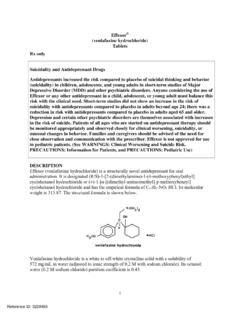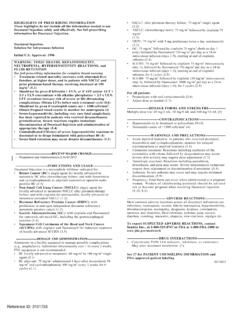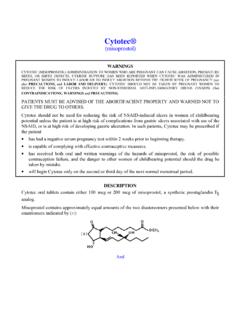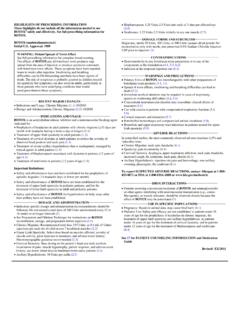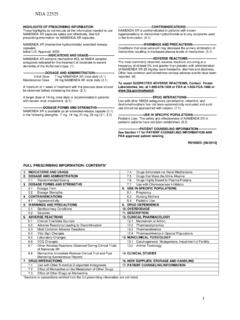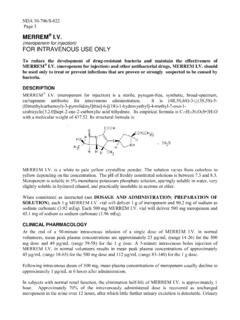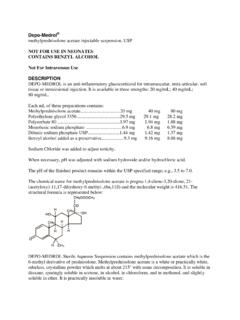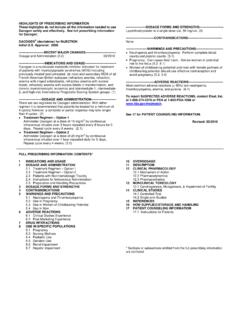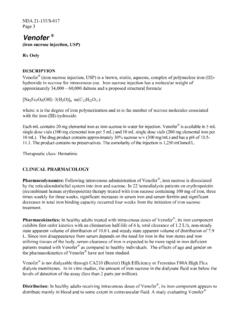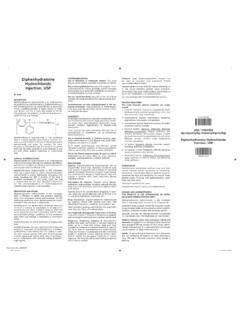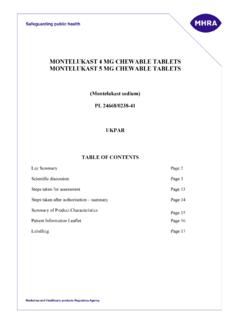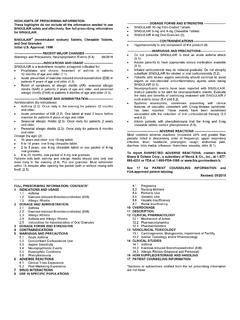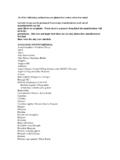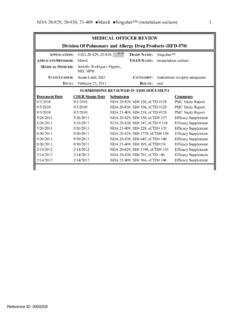Transcription of Singulair (Montelukast Sodium)
1 XXXXXXX Singulair ( montelukast SODIUM) tablets , chewable tablets , AND ORAL GRANULES DESCRIPTION montelukast sodium, the active ingredient in Singulair *, is a selective and orally active leukotriene receptor antagonist that inhibits the cysteinyl leukotriene CysLT1 receptor. montelukast sodium is described chemically as [R-(E)]-1-[[[1-[3-[2-(7-chloro-2 quinolinyl)ethenyl]phenyl]-3-[2-(1-hydro xy-1-methylethyl)phenyl]propyl]thio]meth yl]cyclopropaneacetic acid, monosodium salt.
2 The empirical formula is C35H35 ClNNaO3S, and its molecular weight is The structural formula is: NCl S COO -Na+ HO H3C H3C montelukast sodium is a hygroscopic, optically active, white to off-white powder. montelukast sodium is freely soluble in ethanol, methanol, and water and practically insoluble in acetonitrile. Each 10-mg film-coated Singulair tablet contains mg montelukast sodium, which is equivalent to 10 mg of montelukast , and the following inactive ingredients: microcrystalline cellulose, lactose monohydrate, croscarmellose sodium, hydroxypropyl cellulose, and magnesium stearate. The film coating consists of: hydroxypropyl methylcellulose, hydroxypropyl cellulose, titanium dioxide, red ferric oxide, yellow ferric oxide, and carnauba wax.
3 Each 4-mg and 5-mg chewable Singulair tablet contains and mg montelukast sodium, respectively, which are equivalent to 4 and 5 mg of montelukast , respectively. Both chewable tablets contain the following inactive ingredients: mannitol, microcrystalline cellulose, hydroxypropyl cellulose, red ferric oxide, croscarmellose sodium, cherry flavor, aspartame, and magnesium stearate. Each packet of Singulair 4-mg oral granules contains mg montelukast sodium, which is equivalent to 4 mg of montelukast . The oral granule formulation contains the following inactive ingredients: mannitol, hydroxypropyl cellulose, and magnesium stearate.
4 CLINICAL PHARMACOLOGY Mechanism of Action The cysteinyl leukotrienes (LTC4, LTD4, LTE4) are products of arachidonic acid metabolism and are released from various cells, including mast cells and eosinophils. These eicosanoids bind to cysteinyl leukotriene (CysLT) receptors. The CysLT type-1 (CysLT1) receptor is found in the human airway (including airway smooth muscle cells and airway macrophages) and on other pro-inflammatory cells (including eosinophils and certain myeloid stem cells). CysLTs have been correlated with the pathophysiology of asthma and allergic rhinitis.
5 In asthma, leukotriene-mediated effects include airway edema, smooth muscle contraction, and altered cellular activity associated with the inflammatory process. In allergic rhinitis, CysLTs are released from the nasal mucosa after allergen exposure during both early- * Registered trademark of MERCK & CO., Inc. COPYRIGHT 1998-2009 MERCK & CO., Inc. All rights reserved 1 Singulair XXXXXXX ( montelukast Sodium) tablets , chewable tablets , and Oral Granules and late-phase reactions and are associated with symptoms of allergic rhinitis. Intranasal challenge with CysLTs has been shown to increase nasal airway resistance and symptoms of nasal obstruction.
6 Singulair has not been assessed in intranasal challenge studies. The clinical relevance of intranasal challenge studies is unknown. montelukast is an orally active compound that binds with high affinity and selectivity to the CysLT1 receptor (in preference to other pharmacologically important airway receptors, such as the prostanoid, cholinergic, or -adrenergic receptor). montelukast inhibits physiologic actions of LTD4 at the CysLT1 receptor without any agonist activity. Pharmacokinetics Absorption montelukast is rapidly absorbed following oral administration. After administration of the 10-mg film-coated tablet to fasted adults, the mean peak montelukast plasma concentration (Cmax) is achieved in 3 to 4 hours (Tmax).
7 The mean oral bioavailability is 64%. The oral bioavailability and Cmax are not influenced by a standard meal in the morning. For the 5-mg chewable tablet, the mean Cmax is achieved in 2 to hours after administration to adults in the fasted state. The mean oral bioavailability is 73% in the fasted state versus 63% when administered with a standard meal in the morning. For the 4-mg chewable tablet, the mean Cmax is achieved 2 hours after administration in pediatric patients 2 to 5 years of age in the fasted state. The 4-mg oral granule formulation is bioequivalent to the 4-mg chewable tablet when administered to adults in the fasted state.
8 The co-administration of the oral granule formulation with applesauce did not have a clinically significant effect on the pharmacokinetics of montelukast . A high fat meal in the morning did not affect the AUC of montelukast oral granules; however, the meal decreased Cmax by 35% and prolonged Tmax from hours to hours. The safety and efficacy of Singulair in patients with asthma were demonstrated in clinical trials in which the 10-mg film-coated tablet and 5-mg chewable tablet formulations were administered in the evening without regard to the time of food ingestion.
9 The safety of Singulair in patients with asthma was also demonstrated in clinical trials in which the 4-mg chewable tablet and 4-mg oral granule formulations were administered in the evening without regard to the time of food ingestion. The safety and efficacy of Singulair in patients with seasonal allergic rhinitis were demonstrated in clinical trials in which the 10-mg film-coated tablet was administered in the morning or evening without regard to the time of food ingestion. The comparative pharmacokinetics of montelukast when administered as two 5-mg chewable tablets versus one 10-mg film-coated tablet have not been evaluated.
10 Distribution montelukast is more than 99% bound to plasma proteins. The steady state volume of distribution of montelukast averages 8 to 11 liters. Studies in rats with radiolabeled montelukast indicate minimal distribution across the blood-brain barrier. In addition, concentrations of radiolabeled material at 24 hours postdose were minimal in all other tissues. Metabolism montelukast is extensively metabolized. In studies with therapeutic doses, plasma concentrations of metabolites of montelukast are undetectable at steady state in adults and pediatric patients. In vitro studies using human liver microsomes indicate that cytochromes P450 3A4 and 2C9 are involved in the metabolism of montelukast .
